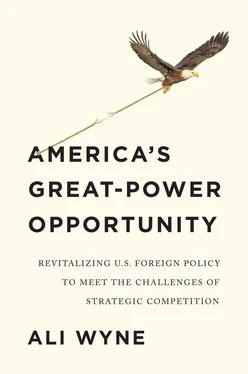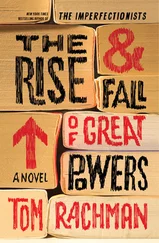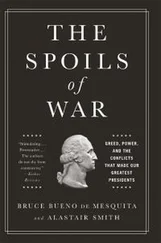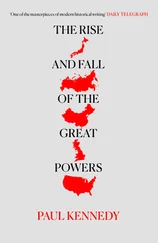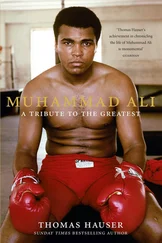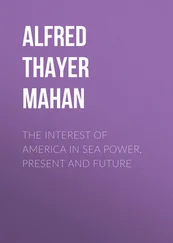The frequency with which policymakers and analysts now discuss great-power competition would suggest that they have converged upon a common interpretation. And yet, while increasingly encountering the term in articles, reports, interviews, speeches, and testimonies, I consistently found myself unable to define it succinctly. I initially conceived of this book, then, as an attempt to redress my own ignorance. The more research I conducted and the more conversations I had while drafting it, though, the more I came to conclude that the shared understanding whose existence I had assumed is overstated. The late Colin Gray, one of the foremost strategic thinkers of the past half-century, observed that this discrepancy between invocation and elucidation plagues many a construct: “A problem with popular formulas can be that their familiarity breeds an unwarranted confidence in interpretation.” 3
There are, of course, certain basic propositions with which most observers agree. First, the phenomenon of interstate competition is longstanding. Second, the emergence of great-power competition as a (if not as the ) principal analytical basis for formulating US foreign policy nods to the reality that the United States is no longer as influential as it was at the end of the Cold War. Third, acting upon their longstanding dissatisfaction with the settlement that emerged in the aftermath of the Soviet Union’s collapse, China and Russia are challenging US national interests and the postwar order; and they are doing so individually and, increasingly, in concert.
But disagreements surface soon after one moves beyond these assertions. What is the essence of contemporary strategic competition? Over what is the United States competing? For what is it competing? What policies should it adopt to be more competitive? How should it assess whether it is succeeding? What would durable strategic arrangements with China and Russia entail? Even a simple list of foundational questions would be far more exhaustive.
It is plain enough to see that the United States confronts a more competitive external landscape. It is more vexing to decide how Washington should adapt. There is a gap, in brief, between description and prescription: while great-power competition captures an important element of geopolitics, articulations of that construct generally do not do enough to illuminate the challenges the United States should prioritize in competing with China and Russia—or the trade-offs it should accept to that end. Many envision instead an all-encompassing contest that will occur in perpetuity, broaching virtually every geographic theater and functional domain.
The management of strategic tensions with China and Russia will be essential to shaping America’s role in the world. But a foreign policy that is predicated upon contesting their actions risks being reactive. Rather than relying upon Beijing and Moscow to furnish its strategic objectives, Washington should identify the contours of the order it would like to help bring into existence alongside its allies and partners—and only then, having formulated an affirmative vision, consider where selective competition with those two countries might contribute to its execution. Selective, because the United States should not and need not compete with them everywhere. Selective, because it will be unable to advance its own vital national interests if it concludes that cooperation with China and Russia on transnational challenges is impossible and that the pursuit of collaborative possibilities signifies competitive weakness. And selective, because neither the American public nor America’s friends will be inclined to participate in an unrestricted competition with Beijing and Moscow.
Whether the United States will be able to formulate a more forward-looking conception of foreign policy remains to be seen. There is little doubt, though, that discussion of great-power competition will continue to grow. There was already a prodigious volume of commentary about it in October 2019, when I submitted the first draft of my book proposal. That volume has increased steadily over the past two and a half years and, as observers assess the Biden administration’s unfolding approach to strategic competition, it will surely continue to grow.
Since I have already mentioned both the Trump administration and the Biden administration, I hasten to note that I have tried to avoid writing a partisan text. There are, of course, likely to be important differences between a Republican-led and a Democrat-led foreign policy. Considering, though, that concerns over China and Russia are growing on a bipartisan basis, the concept of great-power competition is likely to influence America’s approach to world affairs for at least the next few decades. It accordingly demands rigorous nonpartisan examination.
While I have attempted to offer several reasons why I believe that it would be mistaken to adopt great-power competition as the guiding framework for US foreign policy, I am not looking to convince readers of any one critique. I hope, more modestly, that, if they consider those critiques in their totality, they will appreciate the importance of interrogating that framework more rigorously and will consider different ways of conceptualizing how the United States understands its role in the world. One senses in the embrace of great-power competition a relief of sorts that Washington can once more define itself on the basis of its challengers, as it did most notably during the Cold War. There are, however, more compelling and sustainable ways for it to cultivate its identity, two of which readily come to mind: first, reaffirming the promise of its democratic example; and second, contributing to an order that can better withstand the stresses of globalization. The United States is unlikely to recover the degree of preeminence it inherited after the Soviet Union’s dissolution. If it focuses on those two undertakings, though, there is every reason to believe that it will be able to reinvent itself: America’s great-power opportunity is to play a role in the world that will enhance its strategic position no matter what decisions China, Russia, or any other competitor makes.
Fredericksburg, VA
December 15, 2021
1 1. One example is Thomas J. Wright’s All Measures Short of War: The Contest for the 21st Century and the Future of American Power (New Haven, CT: Yale University Press, 2017).
2 2. Uri Friedman, “The New Concept Everyone in Washington Is Talking About,” Atlantic (August 6, 2019).
3 3. Colin S. Gray, Modern Strategy (New York: Oxford University Press, 1999), p. 21.
1 Searching for a Post-Cold War Ballast
The final draft of this book was completed in fall 2021, shortly after the Taliban stormed back to power in Afghanistan. Though most observers had anticipated that the drawdown of US forces would encourage the organization to reassert itself, the speed with which it advanced—and with which the Afghan army collapsed—stunned even the most pessimistic of them: on August 15, just nine days after it had captured its first provincial capital, the Taliban entered the presidential palace in Kabul.
The outcome elicited a heated debate in Washington. Some observers argued that the United States should have maintained a small military presence in Afghanistan to hold the Taliban at bay. Others concluded that it should have accepted defeat and cut its losses far sooner. Some feared that the Taliban’s resurgence would undermine US credibility in world affairs. Others believed that it was the decision to stay in Afghanistan for so long that called America’s judgment into question. Some warned that America’s departure would only exacerbate instability in the Middle East and make it harder for Washington to rebalance to the Asia-Pacific. 1Others assessed that it was precisely this kind of argument that had kept the United States preoccupied while China’s resurgence was transforming world affairs. Although America’s intervention in Afghanistan has concluded, the reckoning over what lessons Washington should learn is likely just beginning. 2
Читать дальше
